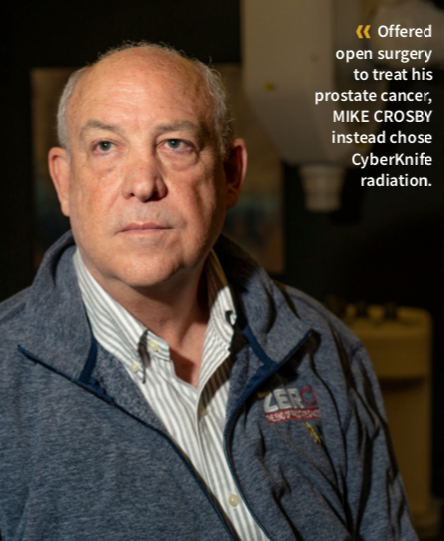Precision Incisions: Minimally Invasive Techniques in Genitourinary Cancer
A variety of minimally invasive techniques can remove genitourinary tumors.
There was a time when open surgery was a given for certain genitourinary (GU) cancers — those of the bladder, kidney, urinary tract and male reproductive system. Typically, a surgeon would make a large incision to remove the tumor, along with surrounding tissue and lymph nodes it may have affected.
In the past two decades, treatment has shifted. Today, more people with GU cancers are being treated with minimally invasive techniques such as laparoscopic surgery, robot-assisted surgery, tissue ablation and surgery done by endoscopy, a flexible tube equipped with a light and a camera that allows doctors to see the inside of the digestive tract. Other techniques, such as high-intensity focused ultrasound, continue to emerge as the treat- ment landscape evolves.

At the core of each of these techniques is precision, which often comes down to millimeters, as tumors and lesions are targeted and treated in place, signifi- cantly reducing tissue injury and healing time.
Urologists are very familiar with endoscopic approaches to the GU tract. “Through this access, they’re able to treat renal pelvic, ureteric, bladder, prostate and urethral problems,” says Dr. Thomas Keane, chairman of urology and chief of the Specialty Surgery Integrated Center of Clinical Excellence at Hollings Cancer Center at the Medical University of South Carolina in Charleston.
THE STATE OF THE ART
Perhaps the best-known minimally invasive technique is laparoscopic surgery. A surgeon inserts a laparoscope, a long thin tube fitted with a tiny camera, through a few small incisions in the patient’s body. Since the 1980s, when technological advances allowed images to be magnified and projected on screen during surgery, the technique has gained widespread acceptance. Laparoscopic surgery now treats a range of GU cancers.
“With a new generation of diagnostic tools including MRIs, computed tomography scans and novel tumor imaging techniques, we can now pretty accurately pinpoint where tumors are and see the nature of the tumor, such as whether it’s solid or cystic,” Keane says. “That allows us to treat the tumor only. The development of minimally inva- sive approaches allows us to do the same things through significantly smaller incisions. It’s remarkable what can be done today that couldn’t be done 20 years ago. However, when necessary, open approaches are still required.”
Laparoscopic surgery has led to the emergence of robotic, or robot-assisted, surgery, in which instruments are attached to a robot’s mechanical arms. The best-known system, the da Vinci surgical system, was approved by the Food and Drug Administration (FDA) in 2000. While seated, the surgeon controls the arms, including a camera arm, from a computer console near the operating table and maneuvers surgical instruments in the patient through a series of small incisions. It can allow for finer manipulation and visualization.
But is robotic surgery better than other procedures?
According to the article “Robotic vs. Standard Laparoscopic Technique — What Is Better?” in the May 2014 issue of Frontiers in Surgery, robotic surgery helps surgeons overcome some of the limitations of traditional laparoscopic surgery, including two-dimensional images and a restricted range of motion with surgical instruments. In other words, robotic surgery allows surgeons to not only see high-definition 3D images but also move the instruments in ways that are beyond the limits of their own two hands.

Advances in these techniques have led to increasing numbers of patients being treated with a minimally invasive approach. Still, it’s difficult to answer the question of whether robotic surgery is always the better choice. There are ongoing studies to assess this in specific situations, whereas in others, the comfort level of surgeons has advanced to the point where it has become the preferred approach.
In the case of minimally invasive radical hysterectomy for cervical cancer, patients were found to have higher recurrence and worse survival compared with open surgery (laparotomy). However, in the GU realm, “Minimally invasive laparoscopic or robotic surgery is now the state of the art for kidney and prostate cancer,” says Dr. Jeffrey Cadeddu, director of the University of Texas (UT) Southwestern Clinical Center for Minimally Invasive Treatment of Urologic Cancer in Dallas. “Generally, open surgery should be reserved for locally advanced invasive cancers that are too big for a minimally invasive surgery. In bladder cancer, it’s more arguable whether one should do laparoscopic surgery or open surgery.” That’s because some lesions in the bladder cannot be fully visualized or surgically treated this way, so it needs to be a case-by-case decision.
The care team drives the decision about which approach to take with a patient, Cadeddu says, adding that scientific literature over the past 15 years supports no difference in survival outcomes between minimally inva- sive and open surgery for prostate and kidney cancers. “If I want to do open surgery, I have to have a good reason,” he says. “I have to be able to explain it to my patient.”
MINIMIZING THE POST-SURGICAL PERIOD
Cadeddu’s patients include Bill Huber, 53, of Dallas. Huber received a diagnosis of stage 3 kidney cancer in November 2017 after a body scan at Cooper Clinic, where his employer sent him for an executive physical. A runner since high school, Huber considered himself in excellent shape but was curious about his cardiac health because his father had died at age 60 of cardiovascular disease.
Although Huber’s heart health was excellent, he was shocked to learn that he had a 6.5-centimeter tumor on his kidney.
He left that day with a referral to Cadeddu. Huber assumed he’d need open surgery to remove the entire kidney, but his conversations with Caddedu convinced him otherwise. “He told me he could remove the tumor and a portion of the kidney and that my odds for a longer life were better with one-and-a-half kidneys instead of just one,” the now-retired executive says.

On Dec. 17, 2017, Huber had robot-assisted laparoscopic surgery. The procedure, which took about four hours, included four half-inch incisions and one 3-inch incision, through which the tumor and part of his kidney were removed. He left the hospital a few days later, with no need for chemotherapy or radiation, and experienced only some post-operative discomfort as his digestive system returned to normal. “I have to believe my recovery was quicker because of the minimally invasive approach,” he says.
Long-term outcomes in prostate cancer are generally the same whether a patient has open or robotic surgery, according to Dr. Isaac Kim, chief of the division of urology at Rutgers Robert Wood Johnson Medical School and chief of urologic oncology and executive director of the prostate cancer program at Rutgers Cancer Institute of New Jersey in New Brunswick. But there are several differences between the approaches when it comes to potential immediate post-surgical impacts. With minimally invasive surgery, Rutgers sees significantly shorter hospital stays, less risk of blood loss and reduced need for blood transfusion, less post-surgical incontinence and lower risk of erectile dysfunction, though the latter depends on the patient’s baseline, Kim says.
In laparoscopic and robotic surgery, carbon dioxide is used to create space inside the patient for the surgeon to work. “This helps maintain a continuous pressure, almost like a gentle hand,” Kim says. “This pressure helps decrease bleeding during surgery. It also leads to a cleaner surgical field. When you can see better, you can do more precise surgery.” But laparoscopic and robotic surgeries aren’t without risk. Though rare, Kim says, carbon dioxide could form a dangerous bubble in a vein. Other risks include infection, bowel perforation and bleeding, as with all surgeries.
The need for chemotherapy or radiation after minimally invasive surgery depends on how advanced the disease is, Kim says. “For example, if a concurrent lymph node removal is done at the time of prostate cancer surgery and cancer is detected, I will refer the patient to a radiation oncologist and medical oncologist,” he says.
In most cases, these minimally invasive approaches are covered by insurance; patients and their doctors can ask health insurers to confirm.
AN EVOLUTION IN CARE
GU cancer care has begun taking a team-based approach, according to Keane. “Urology used to be an isolated field,” he says. Now urologists work closely with other experts to identify tumor types and their genetic profiles, as well as tailored treatments ranging from minimally invasive surgery to targeted therapy, immunotherapy and radiation therapy.
One of the biggest advances in GU cancer care involves the development of multidisciplinary clinics, where teams of urologic oncologists, medical oncologists, radiation oncologists, pathologists and surgeons meet weekly to discuss each patient’s case and make recommendations, Keane says: “This approach offers the advantage of consensus rather than individual opinions.”
Not all treatments are appropriate for all patients, Keane cautions. “Someone will walk in and say, ‘My friend had this.’ But it might not be suitable for them,” he says. Contraindications for minimally invasive treatments can include the type, size and location of the tumor; patient size; past extensive surgical procedures in the area; and any adhesions or scar tissue.
Some bladder cancers can be treated minimally invasively using a cystoscope or resectoscope — a thin, tubelike instrument inserted into the urethra to allow surgery and fulguration (burning away the tumor and its surrounding location with an electric current). New options are emerging to treat bladder cancer, but as with many developing therapies, more research is needed, Keane says.
Other minimally invasive GU cancer treatments include radiofrequency ablation, in which a radiologist uses a thin needle to deliver high-frequency energy directly to a tumor, heating it and killing nearby cells. With cryosurgery, or cryotherapy, liquid nitrogen or argon gas freezes and kills cancerous tissue. These techniques are sometimes used to treat kidney and prostate cancers, typically when surgery is not an option.
For prostate cancer, another emerging treatment is high-intensity focused ultrasound, in which focused ultrasonic beams heat and destroy cancer cells. Studies are still evaluating whether the treatment is adequate and as effective as others. “That takes time,” Keane says. “Quite rightly, the FDA and other agencies demand a lot of evidence.”
Still, waiting can be difficult for someone with a cancer diagnosis. Mike Crosby, 59, of Edmond, Oklahoma, a former U.S. Navy pilot, was told by his Veterans Affairs (VA) care team that an annual blood test revealed an elevated level of prostate-specific antigen, a protein that can rise in men with prostate cancer. When Crosby faced excessive wait times and arranged a biopsy outside the VA system in 2015, he received a diagnosis of intermediate-risk prostate cancer. Told that his only option at the VA was open radical surgery, Crosby did his own research. He ultimately connected with the care team at Swedish Radiosurgery Center in Seattle, where he opted for treatment with stereo- tactic body radiation therapy through a system known as CyberKnife. No incisions are made; instead, using a robotic arm and cameras, focused radiation is delivered precisely to the affected area.
After an outpatient procedure in which four gold markers were inserted in his prostate as a reference point, Crosby returned to the hospital for outpatient treatment of one dose, or fraction, of radiation each day for five days. “I wore a sweatsuit and listened to jazz music for about 45 minutes,” he says. “It was an incredibly easy experience.”
SEEKING OUT A SURGEON
Crosby says he was drawn to stereo-tactic body radiation therapy because it is noninvasive. He also had tremendous confidence in his radiation oncologists, Drs. Sandra Vermeulen and Robert Meier. “I felt comfortable because of the number of procedures Dr. Meier had accomplished,” says Crosby, a CyberKnife advocate who founded Veterans Prostate Cancer Awareness Inc., a nonprofit group that aims to educate veterans and caregivers about prostate cancer and the importance of regular screenings.
“Being treated by someone with the skill of Dr. Meier is like playing in a football game with Tom Brady as your quarterback.”
When it comes to minimally invasive techniques, experience is critical, says Cadeddu, who, according to UT Southwestern, was the first surgeon in Texas to perform ablation for kidney cancer. “In a big city, you should be able to find someone skilled in minimally invasive surgery,” he says. “In a small town, your resources might be fewer.”
Kim, who has performed more than 1,800 robotic prostate surgeries, emphasizes the importance of getting a surgeon referral from someone you trust. Friends and family members can be good sources, as can primary care physicians. He also recommends seeking care at centers that are engaged in clinical trials.
No matter which surgeon you select, ask about their experience, Cadeddu says: “The surgeon should be able to tell you the number of procedures they’ve done, and most will share that right away.” Typically, it’s a good idea to look for someone who’s done at least 200 to 300 over the past few years. That’s because surgeons get better with practice — and because technology is changing.
Kim is particularly excited about single-port robotic surgery. It requires just one small abdominal incision instead of the four needed with the current four-port robot and has the potential to further shorten hospital stays, he says.
“There’s not too much (of a) learning curve for an experi- enced robotic surgeon, as the surgical movement the surgeon uses is essentially the same,” he says. “But never in my wildest dreams did I think I’d see same-day prostate cancer surgery.”
